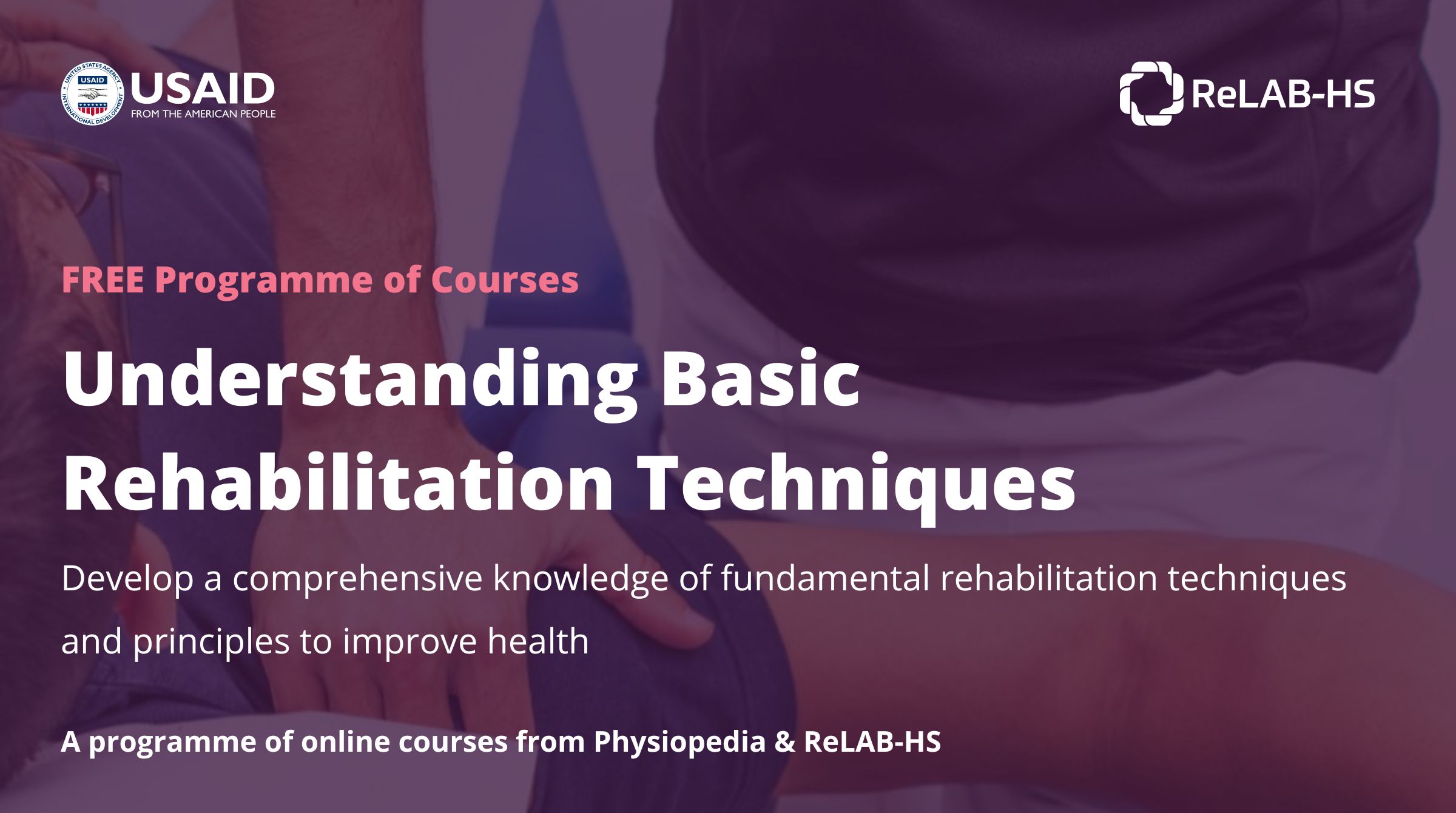Between Monday 4 September and Sunday 1 October 2023 join thousands of colleagues from around the world to develop your knowledge of fundamental rehabilitation techniques to improve health.
This year’s FREE Physiopedia massive open online course (MOOC) is focussing on rehabilitation fundamentals. Once again it is a collaboration between Physiopedia and the USAID-funded Learning, Acting, and Building for Rehabilitation in Health Systems (ReLAB-HS) team. The 4-week course starting on 4 September will equip you with a comprehensive knowledge of rehabilitation techniques so that you can play an effective and proactive role in global and local efforts to increase access to high-quality rehabilitation. It is for all rehabilitation professionals, students and assistants, and the full programme of 8 courses will be free to access, anywhere in the world, for 4 weeks. There will be around 1–2 hours of work for each course and upon passing the final quiz and completion of all of the required learning activities, you will receive a completion certificate as well as CPD (continuing professional development) points and any CEUs (continuing education units) available.
If you are interested in taking part, you can read more about the course below. Make sure you complete the registration form and follow Physiopedia on social media to keep up-to-date with the course in the run-up to the launch on 4 September. Once you are registered, you will receive an email 2 weeks before the start of the course with more instructions for joining us. In the meantime, you can read more about the course on Physiopedia.
This course would be perfect for newly qualified professionals, those returning to practice and indeed anyone looking to hone their skills in the fundamentals of rehabilitation.
Sign Up Now – Registration Form
The MOOC – Understanding Basic Rehabilitation Techniques
The need for physical rehabilitation services is an urgent and growing global issue. According to a recent report, 2.41 billion individuals worldwide live with conditions that would benefit from rehabilitation services, with approximately 1 in 3 individuals requiring rehabilitation services throughout the course of their illness or injury. The proportion of the worldwide population over 60 will double in the next 30 years, the majority of whom will live with chronic diseases, particularly noncommunicable diseases. There are also approximately 150 million children and adolescents who experience disabilities, and injuries for people of all ages are becoming more frequent due to conflict, rapid urbanisation and motorisation. These changing health and demographic trends are contributing to rapid global increases in the numbers of people experiencing decline in functioning, resulting in enormous unmet rehabilitation needs. Much of these unmet needs are concentrated amongst the poorest and most vulnerable populations in low- and middle-income countries and conflict-affected settings, which are often ill equipped to cope with these increasing needs for rehabilitation services.
The World Health Organization defines rehabilitation as “a set of measures that assist individuals who experience, or are likely to experience, disability to achieve and maintain optimal functioning in interaction with their environments”. Rehabilitation is in effect composed of multiple components or interventions to address issues related to all domains within the World Health Organisation’s International Classification of Functioning, Disability and Health (ICF).
These rehabilitation interventions address impairments, activity limitations and participation restrictions, considering contextual factors both personal and environmental, including assistive technology, that impact functioning. When selecting a rehabilitation intervention, it is always important to remember that one cannot change what you cannot measure. Hence, accurate measuring and monitoring using basic rehabilitation techniques, is essential to select and provide appropriate rehabilitation intervention. A therapist’s care plan is only as thorough as their assessment. Confidence in basic rehabilitation assessment techniques is essential for efficient and proper care.
This work is supported by the USAID funded Learning Acting Building for Rehabilitation in Health Systems (ReLAB-HS) project and is not possible without the generous and committed contribution of the Leahy War Victims fund.
ReLAB-HS is made possible by the generous support of the American people through the United States Agency for International Development (USAID) and is implemented under cooperative agreement number 7200AA20CA00033. The consortium is managed by prime recipient, Johns Hopkins Bloomberg School of Public Health.

